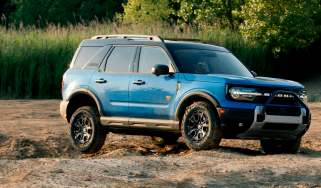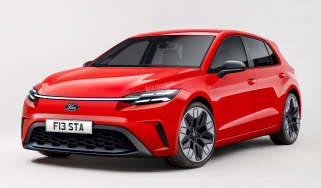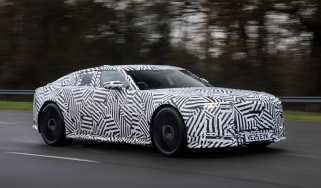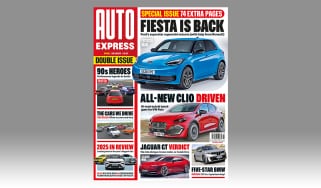Best fast Fords - the greatest high-performance cars ever built by the Blue Oval
We reveal our favourites, from hot hatches to coupés and track legends
Few manufacturers have delivered as many truly iconic performance cars as Ford. From the Le Mans-winning GT40 and the rally-bred Escort Mexico, to the raucous Focus RS and playful Fiesta ST hot hatches, fast Fords have always struck a chord with car enthusiasts across the generations.
So which are the best fast Fords ever made? With so many icons to choose from, it’s a hard question to answer. Everyone has their own favourite depending on era, driving style or personal nostalgia for a particular model. In order to find the standout picks, the team at Auto Express has selected the models that left the biggest mark on them. These cars defined eras, beat the competition, delivered serious thrills to drivers and have earned a place in the fast Ford hall of fame.
Ford GT40
By Ellis Hyde
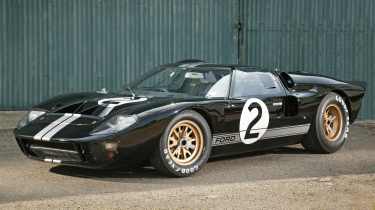
- On sale dates: 1964 to 1969
- Power/engine size: 485bhp/7.0-litre
- Engine/gearbox: V8/four-speed manual
- 0-62/top speed: 4.2 seconds/215mph
- Price new/price now: N/A/£10,000,000
Everyone knows the story: in 1963, Ford tried to buy Ferrari, Enzo regretted the deal at the final hour and this put Henry Ford II on the warpath, determined to prove his company could dominate Ferrari in motorsport. Specifically, at the hallowed 24 Hours of Le Mans. The result was the Ford GT40: the greatest car the company ever made, and one of the most legendary cars ever.
A mixture of British and American expertise brought the GT40 to life, with the first iteration completed less than a year after Mr Ford issued his decree. It stood just 40 inches tall, hence the name, looked like a missile with a windscreen, and a 4.2-litre V8 allowed it to reach 200mph. Just 31 road-going versions were built alongside the racers.
However it wasn’t until the heavily revised Mk2 took to the track in 1966 that the GT40 started to win races, including a podium lockout at Le Mans that year. Thanks in part to a new 485bhp 7.0-litre motor, the car broke lap records and hit 213mph. The GT40 went on to secure four consecutive victories for the Blue Oval from 1966 to 1969.
Ford Cortina Lotus Mk1
By Tom Jervis
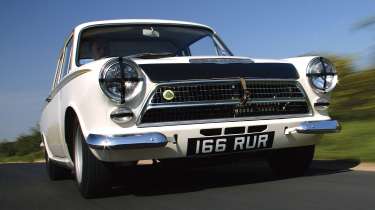
- On sale dates: 1963 to 1966
- Power/engine size: 105bhp/1.6-litre
- Engine/gearbox: 4cyl twin-cam in-line/four-speed manual
- 0-60/top speed: 13.6 seconds/108mph
- Price new/price now: £1,100/£70,000
The Ford Cortina Lotus, as it's officially named, was born after Ford noticed Lotus founder Colin Chapman had commissioned a twin-cam version of the Ford Kent engine for use in the Lotus 23 racing car.
Ford asked Lotus to fit this revised powertrain to the Cortina for Group 2 touring car racing. It produced just over 100bhp, while the car sat on revised suspension and had lightweight body panels in iconic cream and green paintwork. The original plan was to produce just 1,000 examples, but in fact around 7,500 were produced across two generations.
The Cortina took touring car racing by storm, with Jim Clark winning the British Saloon Car Championship with Team Lotus and Sir John Whitmore securing the European Touring Car Championship under the banner of Alan Mann Racing – although this is just touching the surface of the Lotus Cortina’s success.
Shelby GT 500
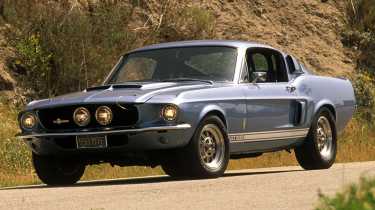
- On sale dates: 1967
- Power/engine size: 355bhp/7.0-litre
- Engine/gearbox: V8 twin-carb/three-speed auto
- 0-62/top speed: 6.5 seconds/128mph
- Price new/price now: £3,700/£150,000
There are plenty of fast Ford Mustangs, but one of the most iconic is the 1967 GT 500 produced by racing driver Carroll Shelby’s firm, Shelby American. Hired to spice up the Mustang and make it more suited to competition, Shelby first created the 289ci V8-powered GT 350 in 1965, with a relatively modest set of modifications including a bigger carburettor, free-flowing intake/exhaust and better brakes.
Then, in 1967, Shelby introduced a new variant using Ford’s 428ci (7-litre) big block V8 making 355bhp in standard tune, and featuring various fibreglass body panels to help keep weight down, but also to give Shelby’s Mustang variant a more aggressive look.
Around 2,000 cars were built, and survivors are highly collectable today. There are plenty of replicas around, too, sporting the iconic twin stripes down the full length of the car, and GT500 lettering on the front wings.
Shelby American continues to market variations of hot Mustangs today, but there’s nothing quite like the original GT 500 – the archetypal sixties muscle car.
Ford Escort Mexico
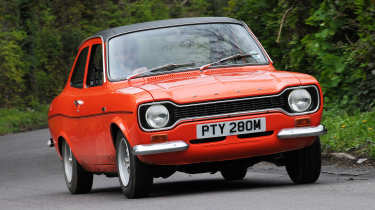
- On sale dates: 1970 to 1975
- Power/engine size: 86bhp/1.6-litre
- Engine/gearbox: 4cyl in-line/four-speed manual
- 0-60/top speed: 10.7 seconds/99mph
- Price new/price now: £1,150/£70,000
In 1970 entrepreneur Wylton Dickson came up with the bright idea of the 16,000-mile London to Mexico Rally, ending just in time for the World Cup in Mexico that year. The winner was the Mk1 Ford Escort, beating the likes of the BMW 2002 Ti, Citroen DS 21 and Mercedes 280 in the process.
To celebrate the win, Ford decided to create a special version of the Escort - aptly named Mexico. Ford had conveniently just built a brand-new plant called Advance Vehicle Operations (AVO) in Aveley, Essex that became the home of the Mexico. Up until AVO’s demise in 1975, 10,352 Escort Mexicos were built.
Its popularity wasn’t based solely on its fabulous Coke-bottle shape, flared wheelarches and unique decals; there was also plenty to get excited about underneath. The 1.6-litre engine only produced 86bhp but it went to 13-inch rear wheels, while the car's superb balance was made all the more enjoyable by responsive steering and a sensational gearshift. True to its rally roots, the Mexico also received a strengthened body, and a revised suspension set-up.
Ford RS200
By Paul Barker

- On sale dates: 1984 to 1986
- Power/engine size: 246bhp/1.8-litre
- Engine/gearbox: 4cyl in-line turbo/five-speed manual
- 0-62/top speed: 6.1 seconds/150mph
- Price new/price now: £49,995/£450,000
The wild RS200 was built to homologate a rally version that didn’t manage to be competitive before the ill-fated Group B cars were banned. Just 200 road cars were built in the mid-eighties, with 246bhp from a mid-mounted turbocharged 1.8-litre Cosworth engine.
In line with the car’s slightly bizarre history, the road-going models were actually built by Reliant, famous for its fibreglass expertise with the not-so-legendary Robin three-wheeler.
Around a third of the car, including most obviously the Sierra tail lights, was from Ford parts bins, but more than 40 years later it can still turn heads at a level massively out of proportion with its success or driving experience. Which is why I love it.
I was fortunate enough to get behind the wheel of Ford’s own heritage RS200, and it’s a heavy and uncompromised beast that you wouldn’t fancy rolling down the high street in. But once you get over the fact that you’re driving a piece of Ford history, and get used to having to be a bit brutal with the controls, it’s a lot more lightweight and excitable than it feels. Clunky and clumsy at low speed, build the confidence to get faster and it dispels any notions of not wanting to meet your heroes.
Ford Sierra RS Cosworth
By Dean Gibson

- On sale dates: 1986 to 1987
- Power/engine size: 224bhp/2.0-litre
- Engine/gearbox: 4cyl in-line turbo/five-speed manual
- 0-60/top speed: 6.5 seconds /149mph (RS500)
- Price new/price now: £20,000/£150,000
Ford shook up the repmobile market with the jellymould Sierra, but it gained a lukewarm reception from conservative car buyers. To help inject some life into the car, Ford Motorsport joined forces with old sparring partner Cosworth to produce a car that would dominate Group A touring car racing.
The road car’s whale tail spoiler and deep front bumper were functional, while the flared arches were designed to accommodate racing slicks. Under the bonnet, Ford’s tried-and-tested 2.0-litre Pinto four-cylinder received a makeover, with the turbocharged YB version making 224bhp in RS500 guise, while racing versions have been tuned to make a reliable 550bhp.
I’ve driven a Sierra RS Cosworth, and it’s the epitome of a turbocharged sports car – it’s very humdrum at lower revs, but there’s instant surge once the turbo spools up. There’s a fine line to tread, too, because too much power will quickly overcome the relatively skinny rear tyres. The rest of the driving experience is great, with decent steering and a nimble chassis that still delivers a relatively comfortable ride.
Ford Escort RS Cosworth
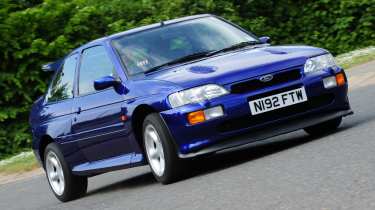
- On sale dates:
- Power/engine size: 224bhp/2.0-litre
- Engine/gearbox: 4cyl in-line turbo/five-speed manual
- 0-62/top speed: 5.7 seconds/150mph
- Price new/price now: £21,380/£75,000-plus
A manufacturer only needs to mutter the words ‘homologation special’ and you know the result will be something a little out of the ordinary. And that was exactly the case with the iconic Escort RS Cosworth – a poster car (alongside the Lamborghini Diablo and Ferrari F50!) of my youth.
Built to allow Ford to go rallying in the nineties, the RS Cosworth was so much more than an Escort with a bodykit and big wing. Fitted with a bespoke, longitudinally mounted Cosworth YBT 2.0-litre engine and a massive turbo, a five-speed manual gearbox and four-wheel drive, cars left the factory with around 225bhp. Few stayed that way due to the highly tunable nature of the powertrain, however. Finding an unfettled example these days is nigh-on impossible.
Do so, and you’ll be knocking on the door of £100,000; it seems some of those who coveted them as a child (me) can now afford (not me) the vastly inflated price it takes to secure one.
Ford Puma 1.7
By Alex Ingram
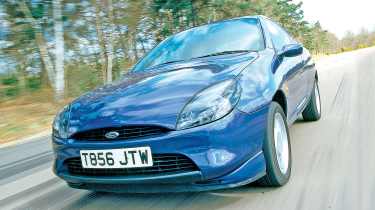
- On sale dates: 1997 to 2002
- Power/engine size: 123bhp/1.7-litre
- Engine/gearbox: 4cyl in-line petrol/five-speed manual
- 0-60/top speed: 8.8 seconds/126mph
- Price new/price now: £14,550/£1,000
Any reader of our sister title evo magazine will know The Knowledge; the back pages where every evo-worthy car’s stats are stated along with the verdict on the car. For a time, two cars stood out for their identical summary, “Pros: Everything. Cons: Nothing.” One of those cars was the Ferrari 550 Maranello. The other was the Ford Puma 1.7.
It might be hard to believe that a little Fiesta-based coupe could be held in the same regard as a Ferrari, but it doesn’t take long behind the wheel of one to appreciate why Evo’s verdict was so on the money.
Firstly, there’s the engine. The Yamaha-developed 1.7-litre is to this day one of the smoothest four cylinder units around, and its appetite for revs let you wring all 123bhp out of it - all of the time. That it’s matched to a sublime manual gearbox is merely a bonus - Mk2 Escort aside, no other Fast Ford shifts as sweetly.
But it’s the chassis that’s the real star. The Mk4 Fiesta was a fine handling supermini in its own right, but the Puma gained a sportier suspension setup and a wider track to make it among the most playful, approachable, communicative and agile cars of its era - and any other. It’s the way that the chassis and powertrain feedback gel so perfectly in the Puma that make it such a delight to drive. While the Racing Puma is more exclusive and slightly quicker, it’s no more fun to drive and becoming hugely expensive now, so the fact that a 1.7 can still be picked up for less than a grand makes it seem like the bargain to topple all Fast Ford bargains.
Ford Focus RS Mk2
By Ryan Birch
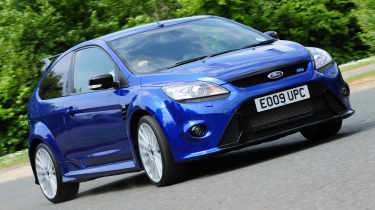
- On sale dates: 2009 to 2011
- Power/engine size: 300bhp/2.5-litre
- Engine/gearbox: 5cyl in-line turbo/six-speed manual
- 0-62/top speed: 5.9 seconds/163mph
- Price new/price now: £27,575/from £22,000
Fast Fords have always been popular with enthusiasts, but fewer cars from the Blue Oval had a bigger impact on the world than when the Mk2 Ford Focus RS was launched.
The car's deep front splitter, side skirts, vents and rear spoiler added the visual clout which made the RS stand out against the Mk2 Focus ST. More importantly, while the RS might have borrowed the same 2.5-litre in-line five cylinder engine from the ST, Ford gave it some serious steroids.
With bespoke pistons and camshafts, a larger Borg Warner K16 turbo, a special exhaust system and a bigger intercooler, the Focus RS produced a stonking 300bhp and 324lb ft of torque. This was more than enough to put some of the best sports cars around at the time to shame.
At low speeds, the Mk2 RS wasn't that different from the regular Focus hatch, just a bit on the firm side. But open the taps up and the car will be tugging from side to side due to the prodigious amount of torque steer it produces. Ford developed the RevoKnuckle front suspension and heavily modified the Quaife limited-slip differential from the first-gen RS, but even that wasn’t enough to eliminate the effect. That’s all part of the charm, though, because the overall driving experience is spot on.
The car had plenty of power and was huge fun to drive. Plus it could do all the practical things the regular Focus could do.
Ford Fiesta ST Mk7
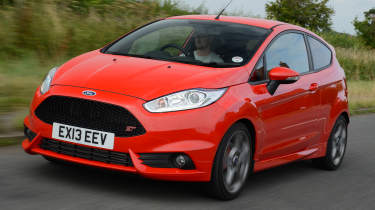
- On sale dates: 2012-2017
- Power/engine size: 180bhp/1.6-litre
- Engine/gearbox: 4cyl in-line turbo/six-speed manual
- 0-62/top speed: 7.0 seconds/142mph
- Price new/price now: £18,950/£6,000-£10,000
Ford’s best drift car ever may well be the Mk7 ST – even though it’s front-wheel drive. This relatively unassuming supermini, with its 1.6-litre engine and tiny wheels changed the hot hatchback genre when it arrived in 2012, with a balance that didn’t just kill fun-sapping understeer, but actively promoted oversteer when off-throttle in a corner.
Many supermini-sized hatches have had a sweet chassis, but here, it's not at the expense of usability. The ride, while very firm on earlier models, wasn’t a bar to daily driving, while the excellent seats and practicality only helped matters.
A sweet chassis balance wasn’t this car’s only ace card, as the turbocharged 1.6-litre four-cylinder ‘VCT’ engine and six-speed manual transmission were just as finely honed and brilliantly executed as the rest of the car.
Sure, some of the interior plastics were a little low-rent; the glovebox lid doubled as a parmesan cheese grater, so rough was its finish, and the infotainment system was more like a child’s game than a grown-up user interface. But this really was a highlight in Ford’s already illustrious career in designing and engineering hot hatchbacks. Shame it’ll never be repeated.
Now you can buy a car through our network of top dealers around the UK. Search for the latest deals…



